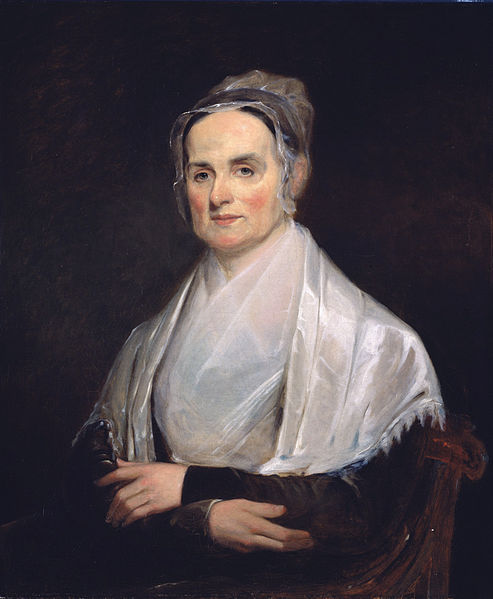TL;DR -- Working to document Chloe. We have all of the stuff necessary. We're telling the tale.
---
Moral: GSMD, and its ways, are unAmerican, essentially. While we work this analysis, we will be updating the WikiTree Profiles of Chloe (Porter) Jackson and her daughter, Myra Hester (Jackson) Gill. We have all of the sources that are necessary; it may take a while to get this filled in.
---
People joke of the 'wall' they found. It's been our experience that most of these examples are from a side branch which represents a collateral family. Or, it might be so far back as to be mostly nuisance, like preventing one to join some mutual-admiration society. The ones that we say need better handling are those of the main line. The fact of an extant person (this case, Chloe (Porter) Jackson) suggests some type of lineage is there from which the person got their mojo.
Recap: Chloe's great-grandfather (Noah Porter) is in the Alden Silver Book. Her sister has descendants in the MF society. One of her Porter uncle's has descendants in the MF society. The details being expanded upon here were covered in a similar analysis that was published in The Gardner Annals (Vol III, No 1, Winter 2016) titled "Flyover country".
This images points to some of the documents that will be covered in the next paragraph. Are we dealing with a mere transformation of style? Not really, as we will show little snips from the documents, themselves. Some groups like a story with snippets related with some text. The Mayflower person's response? I know how to read these documents. Okay? What was the hangup (is my response)?
These bullets will be filled in during this exercise
- Statement of purpose -- Establish that Chloe is the daughter of Lyman Porter and Caroline Hopwood.
- Research strategies -- No direct tie was found to establish that Chloe Porter was the daughter of Lyman Porter and Caroline Hopwood. She was in several U.S. Census reports with the couple (her supposed parents) in which relationships were not explicit. She had several siblings. And, she was married with a daughter prior to an early death. We know something of her daughter who claimed Chloe as her mother. As well, Chloe's father noted that her daughter was his granddaughter. From the persons in Chloe's life for whom we know much more, we look to see how strongly we might find some (set of) associations that can fill the bill (tip the scale). As to scope and scale, all doors will be knocked on as are necessary.
- List of documentation -- These are in order by the exposition offered in the 'Interpretation' section (next). We will note how the references interplay.
- I. U.S. Census, 1850, Montgomery, KY
- II. VR, KY births (1852)
- III. VR, KY, deaths (1856)
- IV. U.S. Census, 1860, New Salem Township, McDonough Co, IL
- V. VR, McDonough Co, IL (1867)
- VI. U.S. Census, 1870, Town of Bardolph, McDonough Co, IL
- VII. U.S. Census, 1870, Mound Township, McDonough Co, IL
- VIII. Findagrave #89404334
- IX.
- X.
- ...
- Interpretation -- The below goes through each of the documents noted prior and describes its support for the 'Statement of Purpose.'
- I. Chloe (Clara A) is in the household of Lyman (31) and Caroline (25) Porter as 2 yo. George Porter is enumerated as 3 yo. The other two in this enumeration were Ransom (5) and William (6/12). Also included is the family of Permelia Hopwood (44) with five children, ages from 19 yo to 4 yo. The next Census (IV) does not include George who died (III).
- II. Emmery Porter born on June 20. Daughter of Lyman Porter and Caroline Hopwood.
- III, George Porter who is in the 1850 Census (I) dies in 1856. -- Porter: George B, son of L & C; d May 27, 1856; age 9y 7m 25d.
- IV. Chloe (Cloey) is in the house of Lyman (41) and Caroline Porter (34) as 12 yo. There is no George enumerated who had died (III). There is Emmira (II) who is 8 yo in the enumeration. Others include Ransom (14), William (10), and Anna (5).
- V. Thomas Jackson marries Miss Chloe A. Jackson (same name that is on her tombstone - see VIII) on 18 Dec 1867.
- VI. Thomas Jackson, head of household, is 23. Chlora is 22. Myra is 6/12. Ann Jackson is 66 (Thomas' mother).
- VII. Lyman Porter, head of household, is 51. Caroline is 45. Others include William (20), Emmira (18), Anna (15), and Josephus (8).
- VIII. Chloe dies 8 Aug 1872. She was 24 years of age. A tombstone is raised for her in the local cemetery.
- IX.
- X.
- ...
- Account for conflicting evidence -- There is no conflicting evidence. Chloe died early, has a tomb stone, was followed by a step-mother, her husband died, his brothers helped the toddler daughter (Myra) with her estate, ...
- Conclusion -- ...
... this will be fun ...
Goal: Turn "this will be fun" into "that was fun".









